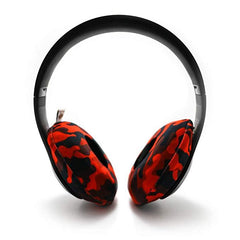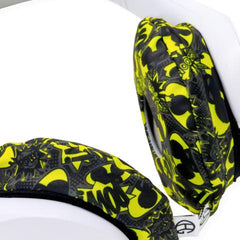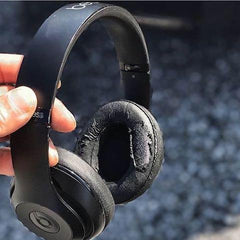Can I Wear My Philips Headphones in the Gym?

Philips has been making high-quality affordable headphones for decades and in 2018 it released the Philips Fidelio X2 offering superb sound quality with a comfortable fit and a very reasonable price tag. These headphones have been billed as a rival to the much-lauded Sennheiser Momentum range.
With the Fidelio range at least, Philips has followed what it calls ‘a simple design philosophy: form follows function’. With 50mm drivers angled towards the ear canal to suppress reflections in the outer ear, the Philips Fidelio X2 is an impressive piece of kit, but whatever model you own there’s one thing that they all have in common: Philips headphones are not designed for use during exercise.
Neither are the Bose QuietComfort 35, the Sennheiser Momentum 2.0, the Sony MX 1000 M2 or the Beats Studio 3 Wireless headphones designed to survive exercise-induced sweat damage either.
Simply put: if you wear your Philips headphones when you exercise then sooner or later they’re going to break.
Sweat Will Ruin Philips Headphones
Sweat is corrosive. When you’re working out moisture will seep into your headphone cushions and you’ll start noticing an unpleasant odour. The leather will start to crack, too, and become unsightly. Even if you persist through that, soon moisture will get into the headphones damaging the electronic components inside, distorting the sound quality until eventually, they’ll stop working altogether.
It doesn’t matter how good of a deal you got on your Philips headphones or how much cheaper some models are compared to Beats or Bose; it’s annoying when things break before their time and if it keeps happening it gets expensive.

It’s not that Philips headphones are poorly made. It’s just that they’re not designed with heavy sweating in mind. The problem for those of us working out in the gym is that the damage is never going to be a one-off. It’s going to happen each time they’re used and that often means multiple times a week.
The only headphones specifically designed to survive the gym were developed by Under Armor and JBL in collaboration with The Rock. The semi-retired wrestler and action movie star complained that no brand of headphone could handle his workouts. Hardly surprising when you see the size of the man and how regularly he hits the weights. The UA Sports Wireless Train Headphones are a pretty decent piece of kit but were designed primarily to be sweat-resistant; they weren’t designed for superb sound quality, comfort or aesthetics.
That’s where the problem lies with gym-proof headphones: it’s often a compromise between sound and durability. Which is one reason why sweat-resistant covers that are compatible with your current headphones are the only option for most people.
EarHugz are certainly the only proactive solution to the problem.

Of course, you could stop wearing headphones at the gym entirely, keeping them safely wrapped up in their carry case at home to enjoy the longest workout of your life without any audio distraction. You could stop sweating, too. You could enjoy the NU-RAVE meets B*Witched mashup piped out of your gym’s PA system. The problem is having a pair of Philips headphones that you want to use but can’t.
Again, the only foolproof solution to this is to use covers that will wick the moisture away from the cushion.
Sweat Can Cause Acne
And the issue isn’t just about the physical damage that excess moisture on cushions can do to a pair of headphones. There’s a health consideration, too.
Sweat doesn’t contain bacteria but it can become an ideal breeding ground for germs and that’s a problem if you’re wearing on or over-ear cans. You could develop exercise-induced acne when sweat forms between the cushions and your skin. What’s concerning, too, is that if you’re prone to middle-ear infections then sweating and wearing headphones could make you ill.
How to Help Protect Your Philips Headphones
One way around this is to use an antibacterial wipe on your headphone cushions as this not only wipes away moisture but will drastically reduce the number of bacteria forming on it. This is good for the skin and it’ll help to minimise irritation on the face. It should help stop any unpleasant smells, too. Unfortunately, this will do very little to protect your Philips headphones from the kind of moisture damage that will stop the speakers working entirely: the sweat will still be able to seep inside no matter how sweetly smelling you’ve made them with a wet wipe.

Philips also do a wide range of in-earphones or earbuds. If you can wear them, they’re a great alternative to headphones. The problem is that they’re not designed for individual ear canals making them impossible for some people to wear comfortably. What fits perfectly for one person will be loose for another. Earphones put you at a higher risk of permanent hearing damage as they deliver music directly into the ear. They can be a bigger hygiene risk, too, where the advantage of portability makes it easier for them to be thrown into the bottom of bags, onto car seats, dropped onto the floor or pushed into a pocket: all places where bacteria is likely to be growing. Headphones seem to demand a greater degree of care. We keep them around our necks, place them onto solid surfaces or fold them back into cases.
Brand loyalty is a big thing for audiophiles or for those who enjoy using headphones. We all have a favourite make or model and often we’ll stick to the same manufacturer, so when one brand brings out a design specification that’s more suitable to our lifestyle (the Project Rock headphones for the gym for example or the PX’s for travelling abroad), then it can be difficult to make that jump to another brand. With headphones, this can mean a loss in sound quality, adding wires where we don’t want them, a change in cup size or aesthetic. What happens, too, when we already have a pair of headphones that we’re completely happy with, that we just don’t want to replace? Should we just run the risk of ruining them during a workout or avoid using them in the gym entirely? If Philips is the brand that you prefer to buy, then you shouldn’t have to jump ship to another just to be able to exercise with music.
It’s one of the reasons that EarHugz are so valuable for anyone who works out with headphones. The sweat-resistant antibacterial covers fit all models of Philips headphones (and Beats, Bose, Sony, Sennheiser and more). They’re way cheaper than buying a replacement set of cans and they come in a range of awesome designs allowing you to be as subtle or as bold in your workout aesthetic as you feel.
They’re machine washable, too, so they’ll stay clean and fresh no matter how much you’re sweating or whether you wear makeup during your workouts.



